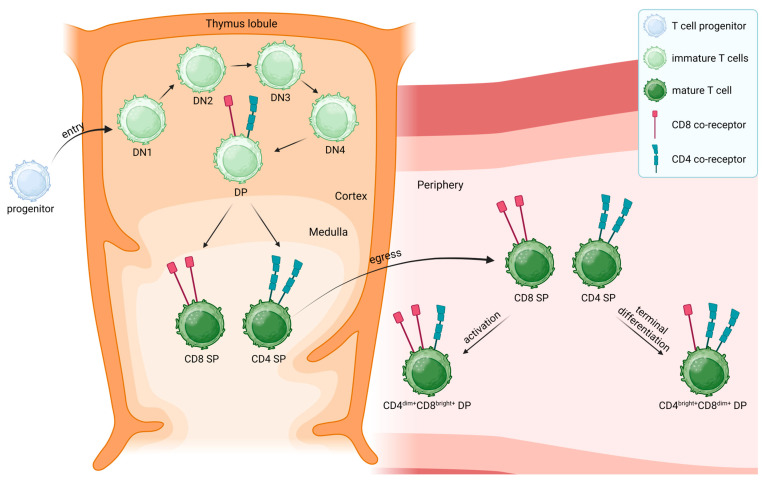Figure 1.
T cell development and potential origin of mature CD4dim+CD8bright+ and CD4bright+CD8dim+ double-positive (DP) T cells. T cell progenitors (light blue) originating from the bone marrow enter the thymus (orange) as double-negative (DN) T cells, which lack the expression of both CD4 and CD8 co-receptors, to undergo positive and negative selections [2,3,38]. Immature DN T cells (light green) go through four stages of differentiation (DN1 to DN4) in which rearrangement of the T cell receptor (TCR) β-chain and the expression of a preTCR expression occur [3]. DN4 T cells undergo rearrangement of the α-chain of the TCR, leading to the transition to immature DP T cells, which express a rearranged TCR and both CD4 (red) and CD8 (turquoise) co-receptors [3]. DP T cells that recognize antigens presented via MHC class II receptors differentiate into mature CD4+ single-positive (SP) T cells (dark green), while recognition of antigens presented by MHC class I molecules results in mature CD8+ SP T cells, which leave the thymus into the periphery [25]. Despite the paradigm that peripheral T cells exclusively express either CD4 or CD8, mature CD4+CD8+ DP T cells were found outside the thymus [8]. These DP T cells can further be divided into two subsets, CD4dim+CD8bright+ and CD4bright+CD8dim+ T cells, respectively [16]. On the one hand, it was suggested that the activation of CD8+ SP T cells may lead to the surface expression of CD4, resulting in CD4dim+CD8bright+ T cells [30]. On the other hand, CD8 expression was suggested to be acquired by CD4+ SP T cells upon terminal differentiation, leading to a CD4bright+CD8dim+ T cell population [32,33]. Created with BioRender.com (accessed on 29.09.2023).

